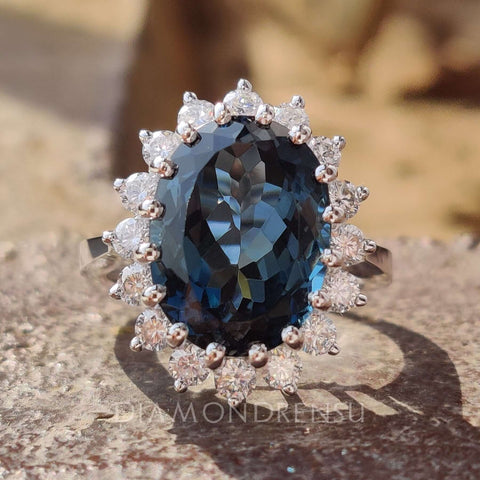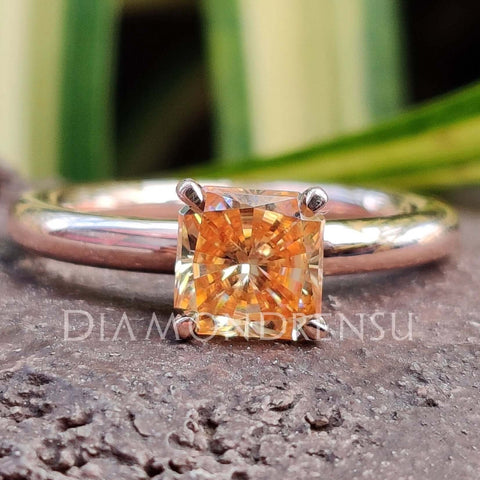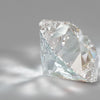
What is Moissanite Fire: Unveiling the Brilliance of this Gemstone
Moissanite, a brilliant and dazzling gemstone, has been increasingly popular as a diamond alternative due to its affordability and stunning appearance. Discovered by French scientist Henri Moissan in 1893, it was originally mistaken for diamonds due to its striking resemblance in terms of sparkle and hardness. Over time, the lab-created version of moissanite has become an attractive option for those seeking a beautiful and sustainable diamond alternative.
Moissanite fire, a unique characteristic of the gemstone, refers to the way it disperses light and produces a fiery, rainbow-like color display. This vibrant effect is even more intense than that of a diamond, as moissanite exhibits a higher refractive index. Lab-created moissanite is made from silicon carbide, a compound that allows for the same stunning optical properties as natural moissanite but with greater availability and affordability.
In the world of fine jewelry, lab-created moissanite is winning hearts not only due to its affordability but also its unrivaled fire and brilliance. With growing demand and a focus on ethical and sustainable gem choices, moissanite has deservedly cemented its place as a stunning and viable diamond alternative.
Historical Context

Moissanite is a rare and naturally occurring mineral that has sparked interest and fascination for over a century. The story of moissanite dates back to its discovery in 1893 by a French scientist named Henri Moissan. He found tiny, sparkling crystals within a meteorite that had fallen in Meteor Crater, Arizona.
Initially, Moissan believed these crystals to be diamonds due to their similarities in appearance and hardness. However, after further analysis, it was determined that these crystals were not diamonds but rather a new, unique mineral made of silicon carbide (SiC). In honor of its discoverer,
Characteristics of Moissanite Fire
Moissanite is a unique gemstone known for its impressive fire and brilliance. Its fire is the result of its high refractive index, which causes light to disperse and create a colorful display of red, green, and other colors when the stone is exposed to light. The refractive index of moissanite is 2.65, which is higher than that of diamond, allowing it to exhibit even more fire than its popular counterpart.
The color of moissanite stones can vary from colorless to near-colorless, as well as showcasing other distinctive hues such as cyan blue, green, and gray. This variety of shades makes moissanite an attractive choice for those seeking a gemstone that is both versatile and visually striking.

In addition to its fiery display, moissanite's luster, which refers to the way the gemstone reflects light, contributes to its unique shine. Moissanite has a higher luster than diamond, giving it a more prominent and vibrant appearance. This combination of fire, color, and luster sets moissanite apart from other gemstones, allowing it to hold its own as a truly captivating and one-of-a-kind gemstone.
When it comes to hardness, moissanite is an excellent option for use in jewelry, with a rating of 9.25 on the Mohs scale, making it one of the hardest materials known to man. This exceptional hardness ensures that moissanite will remain pristine, resistant to scratches, and maintain its brilliant fire for generations to come.
Overall, moissanite fire showcases a stunning blend of qualities, combining a remarkable refractive index, brilliant dispersion, and an array of colors to create a gemstone that offers unparalleled beauty and allure. Its exceptional luster and hardness make it an ideal option for those seeking a durable, yet dazzling gemstone that is both affordable and environmentally responsible.
Mineral Composition

Moissanite is a naturally occurring mineral composed primarily of silicon carbide (SiC). It was first discovered in the late 19th century by the French scientist Dr. Henri Moissan, who initially identified it in a meteorite. Moissanite is a rare mineral that can also be found in the Earth's mantle and in some ophiolitic rocks, where high pressure and temperature conditions foster its formation.
The chemical makeup of moissanite consists of a crystalline lattice formed by strong covalent bonds between silicon and carbon atoms. This arrangement endows moissanite with exceptional properties, such as high hardness, strong thermal conductivity, and resistance to chemical reactions. Due to its durable and stable nature, moissanite is considered to be one of the hardest minerals found in nature.
One of the most striking features of moissanite is its ability to exhibit a brilliant fire. This phenomenon is a result of the gemstone's high refractive index, which leads to the dispersion of light into various spectral colors. The process, often referred to as "fire," is a key characteristic that differentiates moissanite from other gemstones and contributes to its increasing popularity in the jewelry industry.
In summary, moissanite is a rare and naturally occurring mineral composed of silicon carbide. Its unique chemical composition, crystalline structure, and optical properties combine to create the dazzling fire that makes this gemstone highly sought after in the world of jewelry and beyond.
Jewelry Types
Moissanite fire jewelry has been gaining popularity among those who value brilliance, fire, and affordability in their jewelry collection. These stones are an excellent alternative to diamonds, providing comparable beauty and durability at a fraction of the price. In this section, we will discuss various types of moissanite fire jewelry, including rings, necklaces, earrings, and bracelets.
- One of the most popular moissanite fire jewelry types is the moissanite engagement ring. These rings come in a wide range of designs, from classic solitaires to intricate settings that showcase the gem's exceptional fire and brilliance. Princess cut moissanite engagement rings are a popular choice for those who appreciate the sharp angles and precise edge-to-edge sparkle of this cut.
- Aside from engagement rings, moissanite fire jewelry is also available in stunning necklaces featuring pendants with various shapes and designs. Designer pendants with moissanite offer an elegant and stylish addition to any jewelry collection, making them perfect gifts for special occasions.
- Earrings are another popular choice for showcasing the extraordinary sparkle of moissanite fire. From traditional stud earrings to elaborate drop designs, moissanite earrings are versatile and eye-catching, suitable for both casual and formal events.
- When it comes to wrist wear, moissanite fire bracelets are a sophisticated and dazzling choice. These bracelets come in different styles, from delicate tennis bracelets to bold cuffs, and are well-suited for dressing up any outfit.
- Lastly, designer moissanite wedding bands are the perfect way to complement a moissanite engagement ring. They offer a variety of designs, ensuring that couples can find the perfect match to symbolize their love and commitment.
In summary, moissanite fire jewelry comes in various types to suit different tastes and occasions. Whether it's an engagement ring, necklace, earring, or bracelet, there's a moissanite fire piece that will captivate with its exceptional brilliance and fire.
Comparing Moissanite Fire and Other Gemstones

- Moissanite is a gemstone known for its exceptional fire, which refers to the dispersion of light into different colors. The fire of moissanite is higher than that of diamonds, making it an appealing alternative choice for many buyers. Diamonds, highly valued for their brilliance and clarity, also possess some fire, but it is not as pronounced as in moissanite.
- Sapphire and ruby are popular colored gemstones that exhibit their own unique characteristics. While sapphires are prized for their vibrant blue hues, they generally possess less fire than moissanite or diamonds. Rubies, on the other hand, radiate an intense red color and can still exhibit a moderate degree of fire, but again not as much as moissanite.
- White sapphire is often considered as a more affordable option compared to diamonds. It has a similar appearance but does not quite match the sparkle, brilliance, or fire of diamonds or moissanite. This lower fire might make white sapphires a less desirable choice for those seeking a high degree of light dispersion.
- Cubic zirconia is another diamond alternative popular for its affordability and dazzling appearance, but its fire differs from that of both diamonds and moissanite. Although cubic zirconia exhibits a high degree of brilliance, its fire is relatively lower and can sometimes appear slightly cloudy.
- When choosing a gemstone for a piece of jewelry, such as moissanite wedding bands, it is essential to consider the desired balance of fire, brilliance, and color. Moissanite stands out for its exceptional fire, making it a unique and captivating choice for those interested in mesmerizing light dispersion. Ultimately, the choice between moissanite, diamonds, and other gemstones will depend on personal preferences and budget.
Moissanite Fire Cutting Techniques
The fire of moissanite is a significant factor that sets it apart from other gemstones. The fire refers to the dispersion of light within the stone, which results in a kaleidoscope of colors. To achieve this captivating effect, several cutting techniques are employed.
- One popular cutting style is the Asscher step cut, which features a square shape with uniquely angled facets. The interplay of these facets creates a mesmerizing dispersion of light within the stone, enhancing its fire.
- Another cutting technique involves crafting oval cut moissanite. The elongated shape allows the light to traverse more extended paths within the stone, creating a stunning play of colors. The combination of rounded and elongated facets in this cut further accentuates the unique fire of moissanite.
- Likewise, pear cut moissanite stones exhibit spectacular fire due to their teardrop shape and properly angled facets. The rounded end of the stone allows for maximum light dispersion, while its tapered end creates an alluring depth.
- In addition to the cuts mentioned above, the Rensu Collection offers a variety of unique shapes designed to showcase moissanite's breathtaking fire. These shapes include round, princess, oval, emerald, and cushion cuts, all of which are crafted with precision to capture the play of light within the stone.
The cutting techniques employed for moissanite focus on maximizing the light dispersion within the gem, which ultimately enhances its fire. By utilizing various shapes, each facet plays a significant role in capturing and reflecting light to create the mesmerizing display of colors that moissanite is known for.
Care and Maintenance of Moissanite Fire

Moissanite is a popular diamond alternative known for its exceptional fire and brilliance. To keep it looking its best, it's essential to take proper care and maintenance steps.
Firstly, it's important to note that moissanite is a highly durable gemstone. With a hardness of 9.25 on the Mohs scale, it's resistant to scratches and abrasions, making it suitable for everyday wear. Its durability also means that it can be safely cleaned with a variety of methods.
To clean moissanite, use a mild soap and warm water solution. Gently scrub the stone with a soft toothbrush or a jewelry cleaning brush to remove any dirt or debris. Make sure to clean the setting as well, as grime can accumulate in the nooks and crannies, causing the moissanite fire to appear dull.
For more stubborn dirt or built-up grime, an ultrasonic cleaner can be used. This method uses high-frequency sound waves to dislodge particles from the moissanite and setting. However, always consult your jeweler before using an ultrasonic cleaner, as some settings, such as those made from softer metals or with certain gemstone combinations, may not be suitable for this cleaning method.
When storing moissanite jewelry, it's essential to keep it separate from other jewelry pieces. Although moissanite is durable, it can still scratch other gemstones or metals. A soft jewelry pouch or a lined jewelry box with individual compartments is ideal for keeping your moissanite safe and protected.
It's also wise to avoid exposing moissanite to harsh chemicals, such as chlorine or bleach. These substances can damage your jewelry over time and may dull the moissanite fire. To prevent possible contact with chemicals, remove your moissanite jewelry before swimming in a pool or spa, as well as before doing any household chores that involve the use of cleaning products.
In conclusion, taking proper care and maintenance of your moissanite jewelry is crucial in preserving its fire and brilliance. With regular cleaning and appropriate storage, your moissanite will continue to sparkle and shine for years to come.
Market Value and Affordability

Moissanite fire refers to the exceptional brilliance and sparkle of moissanite gemstones. These lab-created gems are growing in popularity and visibility in the jewelry market because they offer impressive visual characteristics at a more affordable price in comparison to diamonds.
One of the leading manufacturers of moissanite is Charles & Colvard, who have been successful in producing a wide variety of moissanite gemstones ranging from classic colorless stones to tinted ones that mimic various diamonds and colored gemstones. The value of moissanite is determined not only by its size but also by its quality and overall appearance. Since moissanite stones are lab-created, they are more sustainable and environmentally friendly than mined diamonds.
Affordability is a key factor contributing to the growing demand for moissanite fire. The cost of moissanite is significantly lower than that of diamonds, making it an attractive alternative for many budget-conscious shoppers. For example, a one-carat moissanite gemstone can cost several times less than a comparable diamond. This price difference allows buyers to consider larger and higher-quality gemstones within their budget, without compromising on the visual appeal of the jewelry.
Another reason for moissanite's popularity lies in its variety of offerings. The gemstones are fashioned into a wide range of cuts and styles, catering to the diverse preferences in the market. From traditional round brilliant cuts to contemporary cushion cuts, moissanite is designed to suit various tastes, allowing consumers to choose pieces that express their unique style and personality.
In summary, moissanite fire represents an accessible and attractive alternative to diamonds in the jewelry market. Its market value and affordability, as well as a wide variety, make it a highly appealing choice for consumers seeking beautiful, high-quality, and sustainable gemstones at a budget-friendly price.
Environmental Impact
Moissanite, a lab-created gemstone, has gained popularity in recent years, partly due to its lower environmental impact compared to the traditional diamond mining process. Diamonds are primarily extracted from kimberlite and lamproite pipes through intensive mining operations. These practices can result in significant environmental damage, including habitat destruction, soil erosion, and water pollution.
On the other hand, lab-grown diamonds and moissanite gemstones require considerably fewer resources and cause less harm to the environment. By opting for these sustainable alternatives, consumers can enjoy the beauty of a diamond-like gemstone without contributing to the negative effects that traditional diamond mining can have on the planet.
Apart from the environmental benefits, lab-created moissanite and lab-grown diamond earrings are virtually indistinguishable from their mined counterparts in terms of appearance, making them an attractive option for consumers who value both aesthetics and sustainability. Moreover, these gemstones come in various designs, such as lab-grown diamond wedding bands and pendants, catering to diverse preferences and tastes.
In conclusion, the production of lab-created moissanite and diamonds offers a more environmentally-friendly alternative to traditional diamond mining. These sustainable gemstones reduce the negative impacts on the environment while still providing consumers with stunning and beautiful jewelry options.
Frequently Asked Questions
How does moissanite fire compare to diamond?
Moissanite fire, or the brilliance of moissanite, is often compared to that of a diamond. The fire refers to the dispersion of light within the gemstone. Moissanite actually has a higher refractive index than diamond, resulting in more fire and brilliance than a diamond. This makes moissanite a popular alternative for those seeking a gemstone with remarkable sparkle and fire.
What materials compose moissanite fire?
Moissanite is a gemstone composed of silicon carbide (SiC). The fire in moissanite comes from its unique crystal structure, which disperses light more efficiently than a diamond. The unique properties of silicon carbide contribute to the eye-catching fire and brilliance that moissanite is known for.
Is moissanite fire created naturally or artificially?
While natural moissanite is extremely rare and found mainly in meteorites, the moissanite used in jewelry is typically lab-created. Due to the rarity of natural moissanite, synthetic moissanite was developed in the 1990s as an alternative to diamonds and other gemstones. The process of creating moissanite enables precise control over its properties, ensuring consistent fire and brilliance in the final product.
Can moissanite fire be used in engagement rings?
Yes, moissanite is a popular choice for engagement rings due to its fire, brilliance, and affordability. As an alternative to diamonds, moissanite is often chosen for its striking appearance and cost-effectiveness. With its durability and lasting beauty, moissanite engagement rings have become increasingly popular in recent years.
How durable is moissanite fire compared to other gemstones?
Moissanite is a very durable gemstone, with a hardness of 9.25 on the Mohs scale. This makes it one of the hardest materials known, second only to diamond, which has a hardness of 10. Its durability and resistance to scratching make moissanite an excellent choice for everyday wear, particularly in jewelry such as engagement rings.
What are the color characteristics of moissanite fire?
Moissanite is available in a range of colors, from colorless to near-colorless, as well as faint hues of yellow, green, or gray. The color of a moissanite gemstone can vary depending on the quality and size of the stone. Colorless moissanite is the most desirable, as it most closely resembles a diamond in appearance. The fire of moissanite is not affected by its color, ensuring the same dazzling display of light in any hue.
Checkout some of our top collections:
Leave a comment
Please note, comments must be approved before they are published.













